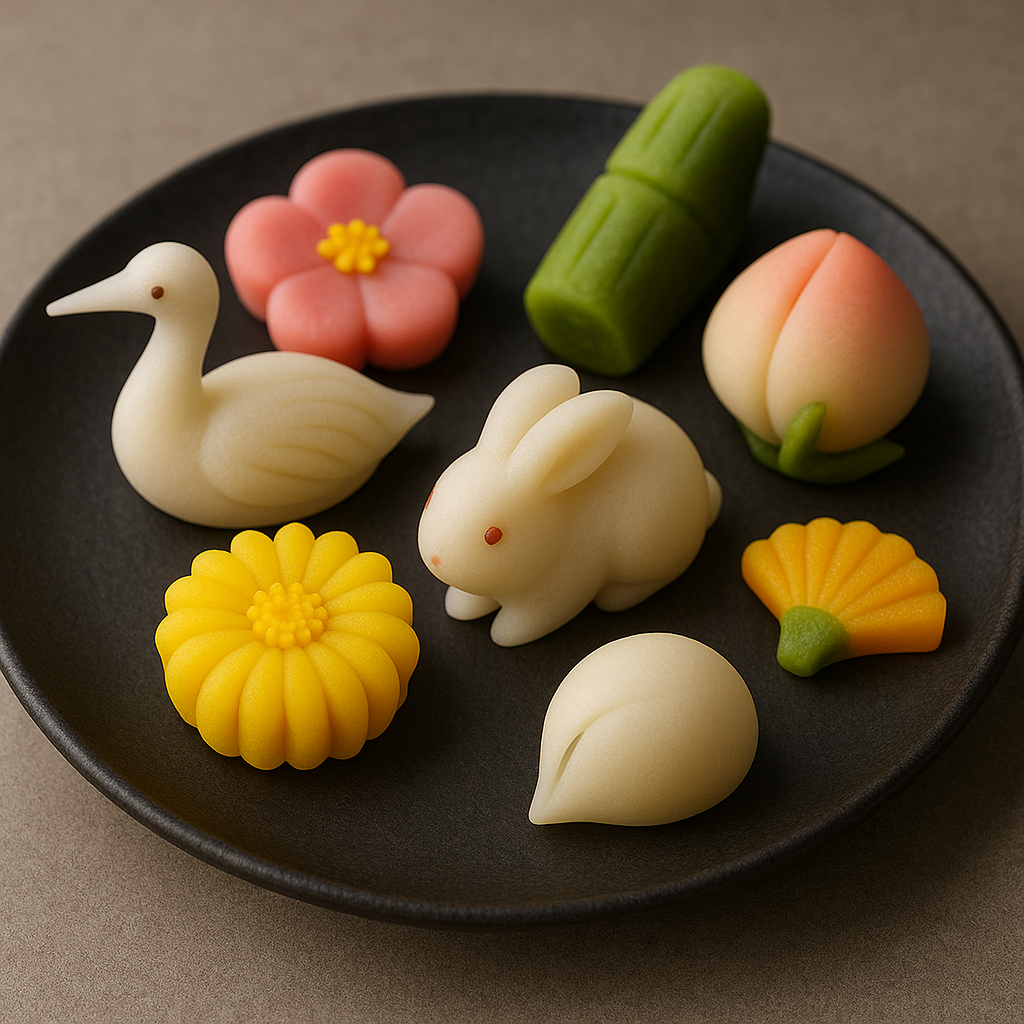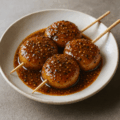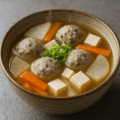ひなまんじゅう(岩手)の特徴
桃の節句を寿ぐ、紅白(ときに三色)の蒸しまんじゅう
ひなまんじゅうは、岩手でも3月3日の桃の節句に供される季節菓子です。ふんわり蒸した生地で餡を包み、紅白(緑を添えて三色にすることもあります)に色づけして晴れやかに仕上げます。素朴な甘さと軽い口当たりが、お茶うけにもよく合います。
形・餡・焼き印に地域の個性が宿ります
丸形のほか菱形や押し型を使うなど意匠が多彩です。餡はこしあん・つぶあんのほか、白あんやみそあんを用いる場合もあり、家ごとの配合や焼き印の意匠が受け継がれています。
ひなまんじゅう(岩手) レシピ
材料(5人分・10個目安)
- 薄力粉 … 200g
- ベーキングパウダー … 小さじ2(約6g)
- 砂糖 … 60〜80g
- 牛乳または水 … 120〜140ml(生地の固さで加減)
- サラダ油 … 小さじ2(しっとり用・任意)
- こしあん(好みの餡でも可) … 200〜250g(10等分)
- 食紅(赤) … 少量(緑は抹茶 少量で可)
- 打ち粉(薄力粉) … 適量
- クッキングシート … 10枚(7〜8cm角)
作り方
- 1. 餡を10等分に丸める。蒸し器に湯を沸かし、ふたに布巾を挟んで滴り防止を準備。
- 2. 薄力粉・ベーキングパウダー・砂糖をボウルで均一に混ぜる。
- 3. 牛乳(または水)とサラダ油を加え、粉気が消えるまでゴムべらで混ぜる(練り過ぎない)。
- 4. 生地を2等分。片方に食紅をごく少量ずつ加えて淡い桃色にする(緑も作る場合は生地の一部に抹茶)。
- 5. 打ち粉をして生地を10等分。丸くのばし、餡を包んでとじ目を下に整える。
- 6. クッキングシートにのせ、強い蒸気で8〜10分蒸す。
- 7. 取り出して粗熱をとり、表面の露を軽くふき、乾いたら盛り付ける。
シェフのワンポイントアドバイス
- 生地は“やわらかめの耳たぶ”が目安です。べたつくときは薄力粉、硬くなり過ぎたら牛乳(または水)で微調整します。
- 色付けはごく少量から重ねると上品にまとまります。天然色(ビーツ/抹茶)もおすすめです。
- 蒸し器のふたに布巾を挟むと水滴で表面がしわになりにくいです。サイズにより蒸し時間は加減してください。
栄養価(1人分の目安)
- エネルギー … 220〜320 kcal
- たんぱく質 … 4〜6 g
- 脂質 … 2〜6 g
- 炭水化物 … 45〜60 g
- 食物繊維・ミネラル … 餡由来
歴史
桃の節句の“紅白”に健やかな成長を託しました
雛祭りでは邪気払いと成長を願う意を込めて紅白(ときに緑を添えた三色)が用いられてきました。ひなまんじゅうも晴れの日を彩る祝い菓子として親しまれてきました。
岩手の家庭に根づく蒸しまんじゅう文化です
蒸し菓子の伝統とともに各家庭で形や焼き印、餡の種類が工夫され、世代を超えて受け継がれています。素朴ながらも行事の席にふさわしい華やぎを添えます。
English Version
Features of Hina Manju (Iwate)
Red-and-white (sometimes tri-color) steamed buns for Girls’ Day
Hina manju are seasonal sweets served on March 3 for the Peach Festival. Soft steamed dough encases sweet bean paste, then is tinted red and white (sometimes adding a green piece for three colors) for a festive finish. Its gentle sweetness and light texture pair well with tea.
Local character in shapes, fillings, and stamps
Beyond round buns, diamond shapes and molded designs are common. Fillings vary—koshi-an, tsubu-an, white bean paste, or even miso-an—while family recipes and decorative stamps are passed down through generations.
Hina Manju (Iwate) – Recipe
Ingredients (Serves 5; about 10 buns)
- Cake flour … 200 g
- Baking powder … 2 tsp (≈6 g)
- Sugar … 60–80 g
- Milk or water … 120–140 ml (adjust for dough consistency)
- Neutral oil … 2 tsp (optional, for softness)
- Sweet bean paste (anko) … 200–250 g (divide into 10 portions)
- Red food coloring … a little (optional green: matcha, a pinch)
- Dusting flour … as needed
- Parchment squares … 10 (7–8 cm)
Directions
- 1. Roll anko into 10 balls. Bring steamer to a boil; line the lid with a cloth to prevent dripping.
- 2. Whisk flour, baking powder, and sugar until even.
- 3. Add milk (or water) and oil; fold just until no dry flour remains—do not overmix.
- 4. Divide dough in half; tint one half pale pink with a drop of red coloring (for three colors, tint a small portion green with matcha).
- 5. Dust, divide into 10 pieces. Flatten each, wrap the anko, and seal; place seam-side down.
- 6. Set on parchment and steam over strong steam 8–10 minutes.
- 7. Remove; cool slightly. Blot any surface moisture and plate once dry.
Chef’s Tips
- Dough target: soft, slightly tacky “earlobe” feel; adjust with a touch of flour or liquid.
- Add coloring sparingly for an elegant tone; natural tints (beet, matcha) work well.
- Lining the lid prevents drips and wrinkling; adjust steaming time to bun size.
Nutrition (per serving, approx.)
- Energy … 220–320 kcal
- Protein … 4–6 g
- Fat … 2–6 g
- Carbohydrates … 45–60 g
- Fiber & minerals … mainly from the bean paste
History
Red and white for health and growth
Hinamatsuri customs use auspicious red and white (sometimes with green) for protection and wishes for children’s growth; hina manju brighten the celebratory table.
A steamed-bun tradition rooted in Iwate homes
Alongside regional steamed-sweets culture, families have preserved their own shapes, stamps, and fillings, passing down a simple yet festive confection.



何でも質問してください!